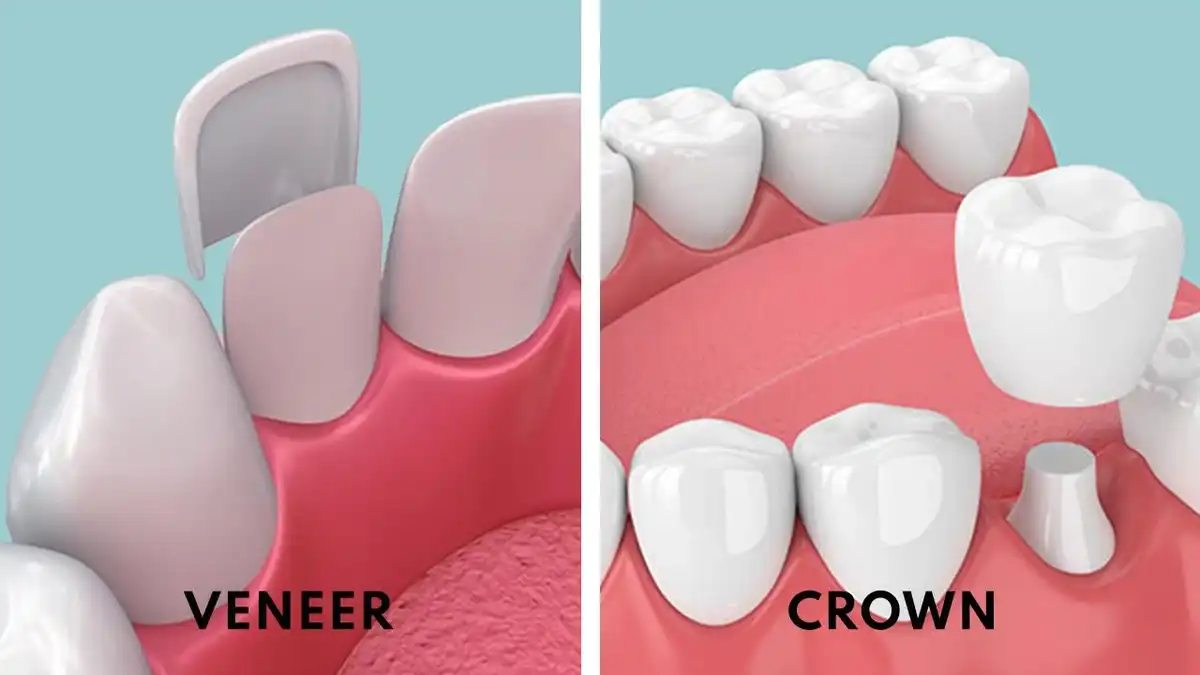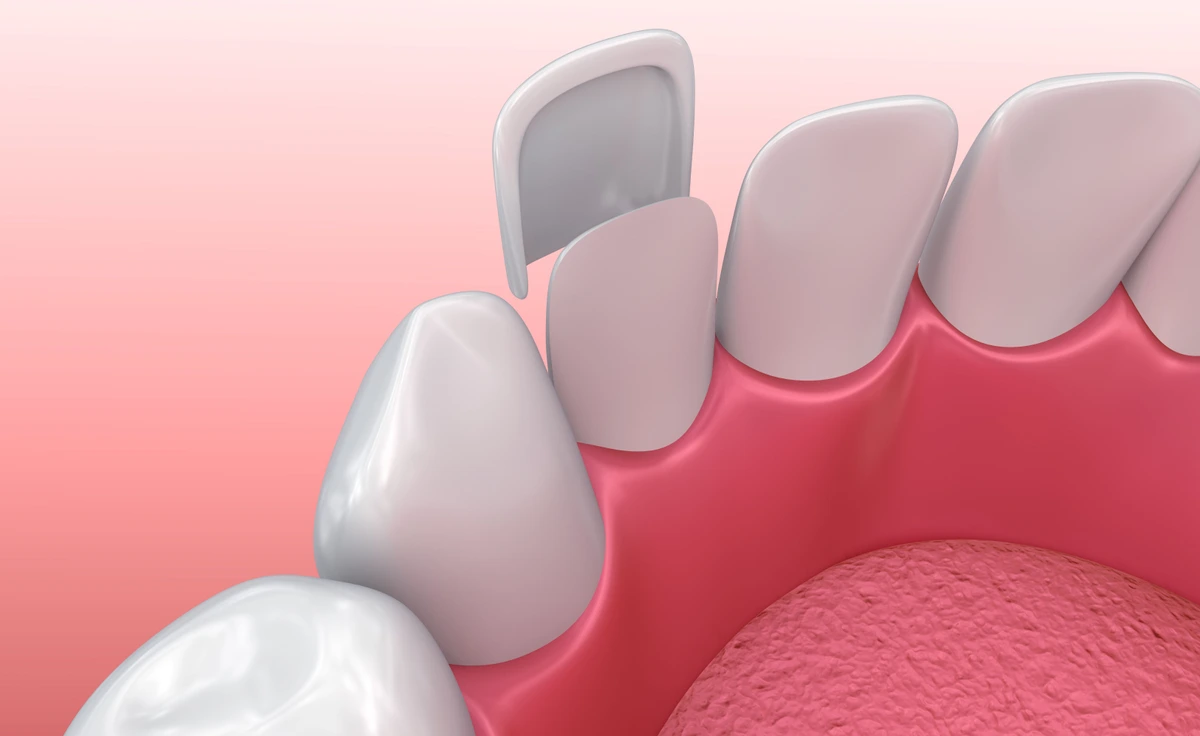Veneers vs. Crowns: What's the Difference & Which is Better


When it comes to repairing or enhancing front teeth, crowns and veneers both offer significant advantages. But functionally and aesthetically, veneers vs. crowns serve two completely different purposes. Dental crowns (aka “tooth caps”) cover your entire tooth, while veneers only cover part of them.
Deciding between crowns vs. veneers on front teeth will be different for everyone. The biggest factor will depend on if your tooth is healthy or not, or if it just needs an aesthetic enhancement. One restoration (dental crowns) repairs broken teeth while also complementing their appearance, while the other (veneers) is strictly cosmetic in nature.
What Is The Difference Between A Veneer And A Crown?

Although some people call them “tooth caps”, crowns are full-coverage restorations that act like a tiny little helmet that goes over your tooth. The protective shell covers the entire tooth surface all the way up to the gumline, completely sealing it underneath. For front teeth, crowns are used when the tooth is structurally unsound. In other words, it’s cracked, has a large cavity, broke off, or you just had a root canal performed (root canal teeth are extra brittle.) Your tooth needs a crown to keep it functioning properly. Otherwise, it would just deteriorate and the tooth would probably have to be extracted.
What Is A Veneer?
Technically speaking, dental veneers are cosmetic restorations that are placed on teeth on an elective basis. People choose to get dental veneers to make their smiles look better. They basically mask the natural teeth behind them, immediately enhancing the overall look and color of your enamel.

Veneers tend to come in one of three variations: porcelain, no-prep, or composite (chairside.) Porcelain offers the best durability and aesthetic results, making them the standard for most smile makeovers.
Advantages Of Veneers:
- Addresses your entire smile zone at one time
- Makes your smile look gorgeous
- Can replace the need for whitening or braces (in some cases)
- Tailored to your individual preferences
Disadvantages Of Veneers:
- Can be expensive
- Are usually non-reversible
- You need several of them at a time
- Usually isn’t covered by insurance
- Budget veneers don’t look as good
What Is A Crown?
Crowns or “caps” are the next-level restoration your dentist uses if your tooth is too damaged to repair with a filling. Since they go over and around your tooth, it helps to reinforce any weak or broken structures underneath. Basically, they distribute pressure so that you can use your tooth for normal biting and chewing. Without a crown, it’s usually just a matter of time before a compromised tooth breaks down even more.

Your tooth is typically reduced down to a smaller size before a crown will fit over it. Otherwise, it would “hit too high” or look too bulky overall. Reshaping the tooth on the top and each side will allow a crown to slip over it completely without getting in the way.
Advantages of Crowns:
- Usually covered under your dental insurance policy
- Can be placed on just one or two teeth, instead of several
- Protects teeth with cracks or cavities
- Enhances the tooth’s appearance while also protecting the weak structure
Disadvantages of Crowns:
- Is more invasive to your tooth than a dental veneer
- Typically only placed on one tooth at a time
- Used on an as-needed basis, rather than upon request
- Could have a visible metal base, depending on the design and materials used
Which One Is Right For You?
Deciding between dental veneers vs. crowns is actually a fairly straightforward process for most people. You need a crown if you have a single tooth that structurally can’t stand up to everyday wear and tear anymore. The crown protects the tooth when it’s already compromised. You also need a crown if you recently had a root canal or there was a really large cavity that bombed out the inside of your tooth. Veneers can’t help with any of those situations.
On the other hand, you want to go with dental veneers when aesthetics is your main concern. You just want your teeth to look whiter, straighter, and properly shaped from one side of your mouth to the other. In that case, you would want to have however many dental veneers it will take to cover all of the upper teeth in your “smile zone.”
Typically, that number is somewhere between 6-10 veneers, depending on how wide your smile is.
Which One Lasts Longer: Veneers Or Crowns?
Keep in mind, if you’re getting “same-day” dental veneers, the material used for those restorations isn’t nearly as durable as porcelain. Same-day veneers typically last a few years at most before they need to be changed out.
Since most quality veneers and crowns are made from the same durable materials, the best way to help your investment last as long as possible is to floss daily and sleep in a nightguard.
Crowns Vs. Veneers Cost
Which costs more: crowns vs. veneers on front teeth? There are several variables that will impact the total out-of-pocket cost.
| Dental Procedure | Average Price with Insurance | Average Price with No Insurance |
|---|---|---|
| Dental Veneer | typically not covered | $925 to $2,500 per tooth |
| Dental Crown | $600 to $950 per tooth | $800 to $1,500 per tooth |
Questions To Consider:
How many do I need?
Usually, if someone is getting a crown, it’s only here or there on teeth that they already have problems with. But crowns address the entire scope of your smile. If you’re someone who shows more teeth when you’re smiling or laughing, you typically need more veneers than someone else.
Side note: veneers usually are not recommended on lower front teeth, because they’re at an increased risk of chipping.
Which type am I getting?
The materials used to make your crown or veneer will impact the total cost for each restoration. Some may only cost a couple of hundred dollars, while others are $800 or more. Since many different materials are available on the market, be sure to ask your dentist about the pricing tiers for different crowns and veneers.
Even though you probably wouldn’t get one on your front tooth, gold crowns are a good example. Gold prices go up and down with the market, which then impacts the price you pay in the dental office. Similarly, there are different types of ceramic materials that your dentist or lab has to choose from.
Is it covered by my dental insurance?
As a general rule, dental crowns tend to fall under insurance benefits while cosmetic veneers do not. There are occasionally exceptions to the rule, but they’re few and far between. And even if crowns are covered under your dental insurance, you’ll need to consider your deductible, co-pay amounts, and annual maximum that’s allowed under your plan.
Are extra treatments necessary?
Custom color-matching, gum lifts, buildups, and sedation are just a few examples of added costs you might need to consider. These are all unique to each individual, so you and your dentist will need to discuss them during your exam.
The number of appointments involved.
Time is money. Especially when you’re having to miss work to get dental treatment. If your dentist offers same-day treatments like CEREC crowns or no-prep Lumineers, these crown or veneer variations could save you an extra trip to the dentist’s office.
Ask Your Dentist
Are you still debating if you need crowns vs. veneers on front teeth? Don’t overthink yourself. Definitely talk to your dentist. Or when in doubt, get a second opinion. It should almost always be a clear-cut decision between which of the two you actually need. A second opinion is a great way to tap into professional advice when you’re feeling unsure about your next steps.
Whether you’re seeing a general dentist or one who focuses on cosmetic services, both should be able to give you an honest opinion about which restoration is best. Because in reality, a crown can still enhance the appearance of your smile, but it’s just focusing on one tooth at a time. Sometimes having your dentist repair a broken or missing tooth can have a huge impact on your smile overall.
When you visit your dentist, be sure to provide your insurance information. Their treatment coordinators will work up a care plan that outlines the fees, copays, estimated coverage, and all of the total costs involved. You’ll have a great idea of what to expect before committing to anything. Consult with a local dentist here.
Crowns Vs. Veneers Recap
Crowns vs. veneers on the front teeth are a matter of aesthetics vs. structural needs. What’s your overall goal? If it’s to repair broken front teeth, crowns are the answer. Is it to cover multiple healthy teeth to change the way they look? Then veneers are your go-to choice. And even if they aren’t covered by your dental insurance, flexible financing and options like 0% interest are usually available!

Make your inbox smile!
Subscribe






